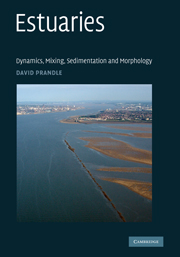Book contents
- Frontmatter
- Contents
- List of symbols
- 1 Introduction
- 2 Tidal dynamics
- 3 Currents
- 4 Saline intrusion
- 5 Sediment regimes
- 6 Synchronous estuaries: dynamics, saline intrusion and bathymetry
- 7 Synchronous estuaries: sediment trapping and sorting – stable morphology
- 8 Strategies for sustainability
- Index
- References
8 - Strategies for sustainability
Published online by Cambridge University Press: 01 September 2009
- Frontmatter
- Contents
- List of symbols
- 1 Introduction
- 2 Tidal dynamics
- 3 Currents
- 4 Saline intrusion
- 5 Sediment regimes
- 6 Synchronous estuaries: dynamics, saline intrusion and bathymetry
- 7 Synchronous estuaries: sediment trapping and sorting – stable morphology
- 8 Strategies for sustainability
- Index
- References
Summary
Introduction
Rising sea levels and enhanced storminess, resulting from Global Climate Change (GCC), pose serious concerns about the viability of estuaries worldwide. This book has shown how related impacts are manifested via evolving interactions between tidal dynamics, salinity intrusion, sedimentation and morphology.
Drawing on a case study of the Mersey Estuary, Section 8.2 assesses the capabilities of a fine-resolution 3D model against the perspective of a 100-year record of changes in tides, sediments and estuarine bathymetries. Both historical and recent observations are used alongside the Theoretical Frameworks, described in preceding chapters, to interpret ensemble simulations of parameter sensitivities and so reduce levels of uncertainty surrounding future forecasts.
There is an urgent need to develop models that can indicate the possible nature, extent and rate of morphological changes. With accurate information on bathymetry and surficial sediment distribution, ‘Bottom-Up’ numerical models (i.e. solving momentum and continuity equations as in the Mersey study) can accurately reproduce water levels and currents. However, simulation of sediment regimes involves net fluxes generally determined by non-linear coupling between flow and sediment suspension, i.e. processes over much wider spectral scales. Future forecasts must encapsulate a broad spectrum of changing conditions, consequently the range of possible future morphologies widens sharply. While ‘Bottom-Up’ numerical models can be used for sensitivity analyses to identify areas susceptible to erosion or deposition, longer-term extrapolations become increasingly chaotic. As an alternative to ‘Bottom-Up’ models for forecasting bathymetric evolution, geomorphologists use ‘Top-Down’, ‘rule-based’ models (Pethick, 1984).
- Type
- Chapter
- Information
- EstuariesDynamics, Mixing, Sedimentation and Morphology, pp. 205 - 233Publisher: Cambridge University PressPrint publication year: 2009



